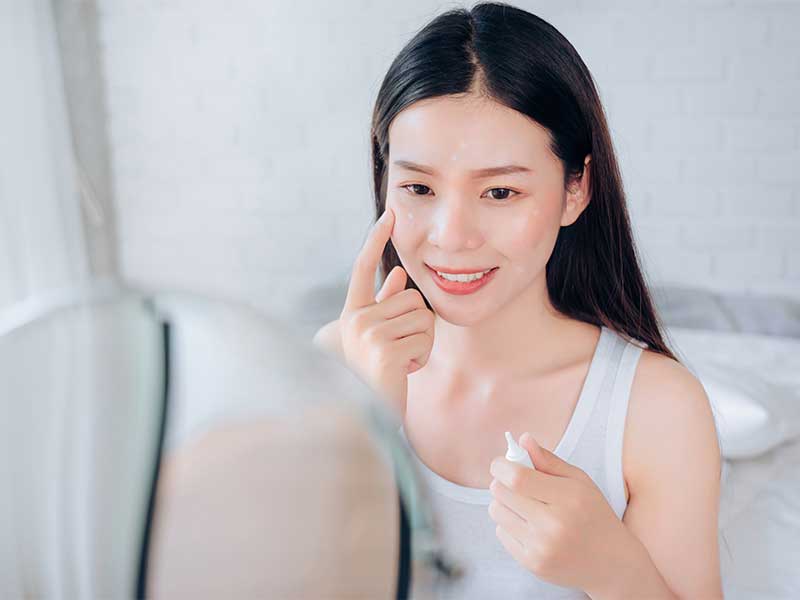

Succinic acid was traditionally produced synthetically from fossil oil or by an expensive distillation of amber. During the last decade, new methods of production through biotechnological processes have been developed industrially (so-called bio-succinic acid). Looking for more natural ingredients, the cosmetics market now has access to a new affordable plant-based ingredient.
Bio-succinic acid: A new natural potent multifunctional agent
Succinic acid is an aliphatic dicarboxylic acid (diacid) described by the empirical formula C4H6O4, and is naturally found in living organisms. This diacid is one entry pathway into the Krebs cycle that takes place inside the mitochondria found in all cells in the human body. Succinic acid provides energy required for the organism to function and is therefore involved in a variety of important biological actions.
Widely used in the food industry as a chelating agent and as a pH adjuster, succinic acid has been recognized as a safe substance for years (1). Studies also proved its antioxidant properties (2) especially for cosmetics. Succinic acid is also a fully safe intermediate to manufacture derivatives like emollients, surfactants and emulsifiers used in cosmetic formulations.
Bio-succinic acid offers a wide array of cosmetic uses
- Antimicrobial agent: Organic acids like sorbic, benzoic and salicylic acids have been used for decades in topical application products as preservative systems, but all face a poor solubility in water. Bio-succinic acid is shown to have a much higher and favorable solubility in water and be an efficient and easy-to-use preservative booster. An initial investigation into the Minimum Inhibitory Concentration of bio-succinic acid, carried out with salicylic acid used as a benchmark, has demonstrated that bio-succinic acid shows a decrease of microbial growth of above 99.9% at concentration as low as 0.1% against the strains of S. Mutans, P. Acnes and G. Vaginalis, thus outperforming salicylic acid effects (3).
- Anti-acne treatment: Bio-succinic acid can be used in as an efficient alternative for salicylic acid or as a booster for other anti-acne ingredients (4). New studies are ongoing to prove an activity against more strains, which could extend its use in cosmetics.
- Antioxidant activity: Bio-succinic acid is able to reduce intensity of the lipid peroxidation, and therefore may act as an anti-pollution agent (5) and improve cosmetic product stability.
- Collagen degradation inhibitor: Studies in the field of oncology seem to suggest this activity, meaning that bio-succinic acid could act as an anti-aging agent (5).
- Mitochondrial activity enhancer: Succinic acid can enhance mitochondrial activity in skin cells (6) and may show a potential use in products with skin energizing and revitalizing effect. The increase in oxygen consumption may accelerate fat cell metabolism, proving useful in improving lipolysis, in anti-cellulite and slimming products.
- Cell hyperproliferation prevention: Succinate has been shown to inhibit cell proliferation stimulating mitochondrial respiration (7). This ability may be useful in the prevention of hyperproliferation at skin level, e.g., in psoriasis or hyperkeratosis prevention.
Bio-succinic acid and Ecocert certification
Bio-succinic acid is an Ecocert-authorized ingredient, non-GMO and derived from 100% renewable vegetable feedstock. It is a safe, sustainable and multifunctional alternative to other widely used acids in cosmetics. This natural, new ingredient also delivers specific interesting benefits as antimicrobial, anti-acne, anti-psoriasis, antioxidant, and slimming agent. Easy to use, it allows the development a large range of cosmetics or toiletries such as body washes, shower gels, scrubs and exfoliation products, shampoos and soaps with antimicrobial properties and much more.
1. https://www.accessdata.fda.gov/scripts/fdcc/?set=SCOGS, consulted on 22 December 2017
2. Palagina I.A., Ukr Biochem J, 89(4), 22-33 (2017)
3. Theunissen L. & Courbès F., H&PC Today - Household and Personal Care Today, Vol.12(2) March/April 2018
4. Wang Y. et al, Appl Microbiol Biotechnol, 98(1), 411-424 (2014)
5. Xiao M. et al, Genes Dev, 26(12), 1326-38 (2012)
6. Palsson-McDermott E.M., O’Neil L.A., Bioessays, 35(11), 965-973 (2013) - Huffman K.M. et al, Diabetologia, 57(11), 2282-2295 (2014)
7. Wittwer J.A. et al, Cancer Prev Res (Phila), 4(9), 1476-1484 (2011) - Wenjuan L. et al, Cancer Prev Res (Phila), 8(6), 487-491 (2015)













